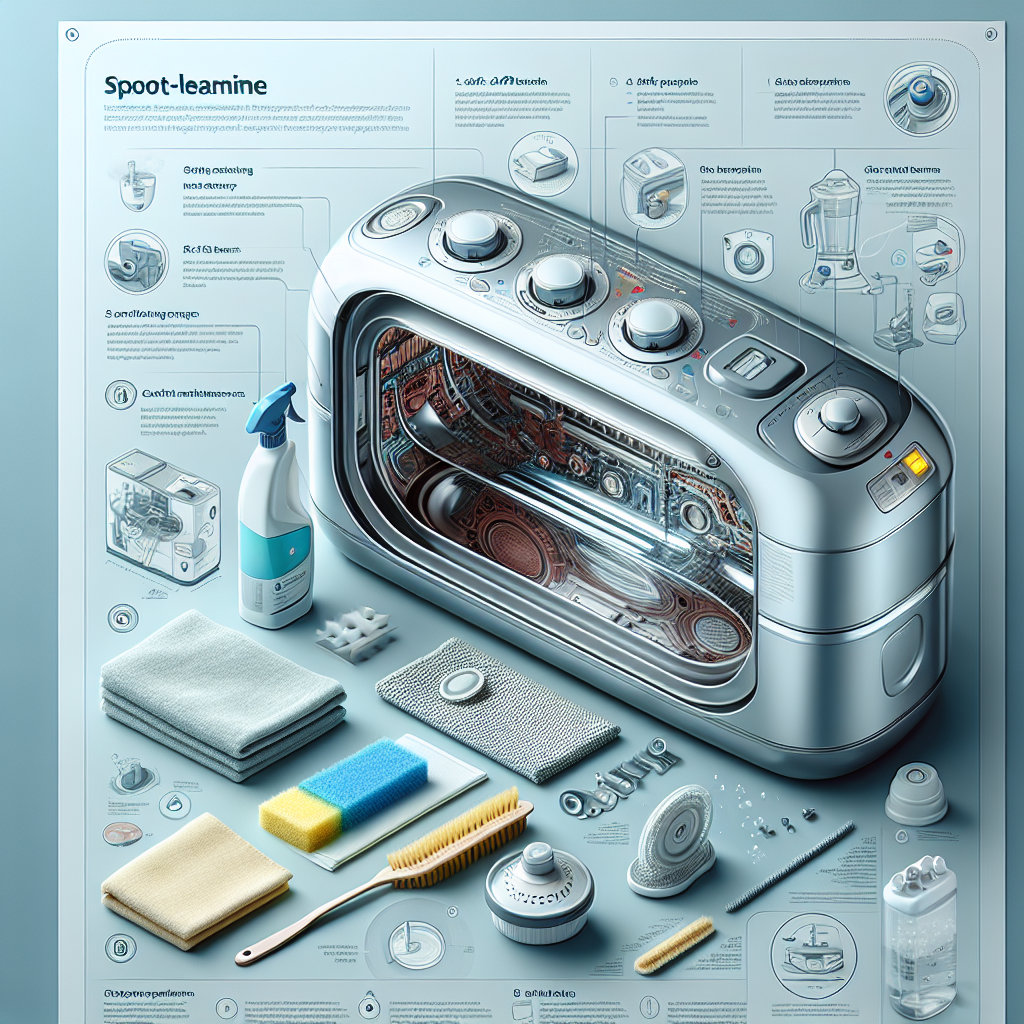How Do I Clean And Maintain My Steamer?
Are you a proud owner of a steamer but find yourself unsure about how to properly clean and maintain it? Well, fret no more! In this article, you will discover some simple yet effective tips and tricks that will keep your steamer in tip-top shape, ensuring it remains a reliable and efficient tool for all your garment care needs. From regular cleaning to troubleshooting common issues, we’ve got you covered. So, let’s dive right in and unlock the secrets to keeping your steamer running smoothly!
Understanding Your Steamer
Steaming is a convenient and effective way to remove wrinkles from your clothes and freshen up fabrics and upholstery. To fully harness the power of your steamer, it’s important to understand its different parts and how they contribute to its functionality and limitations.
Know the parts of your steamer
Your steamer is made up of several key components. The main body houses the heating element, while the water tank holds the water that is used to generate steam. The nozzle is where the steam is expelled, and it is often equipped with additional attachments for different steaming purposes. Additionally, there may be a control panel or dial that allows you to adjust settings such as temperature and steam intensity.
Know the steamer’s functionality and limitations
While steamers are great tools for removing wrinkles, it’s important to be aware of their limitations. Steamers work best on lighter fabrics such as cotton and polyester, but may not be as effective on heavier materials like denim or wool. It’s also important to note that steamers are not designed to remove stains or odors from fabric. Understanding these limitations will help you manage your expectations and get the best results from your steamer.
Before-Use Maintenance
To ensure the optimal performance of your steamer, it’s important to carry out a few maintenance tasks before each use.
Inspect your steamer
Before using your steamer, take a few moments to inspect it for any visible damage or worn-out parts. Check the power cord for any fraying or exposed wires, and ensure that the nozzle is in good condition. It’s crucial to address any issues beforehand to prevent potential accidents or damage to the steamer.
Checking the water tank
The water tank is a vital component of your steamer, as it is responsible for generating the steam. Before each use, check the water tank to ensure it is adequately filled. Many steamers have a maximum fill line that should not be exceeded, so be mindful of this to prevent overflows. Additionally, inspect the tank for any signs of buildup or residue that may affect the steamer’s performance.
Testing the steamer’s performance
Before steaming your clothes or fabrics, it’s a good practice to give your steamer a quick test run. This will help ensure that it is functioning properly and that there are no issues with the steam flow or temperature settings. Run the steamer for a few seconds to let it warm up and check if the steam is emitted consistently and at the desired intensity. If you notice any irregularities, refer to the manufacturer’s instructions for troubleshooting or consider seeking professional help.

Routine Cleaning after Use
Proper cleaning after each use is essential to maintain the longevity and efficiency of your steamer.
Emptying the steamer
After using your steamer, always empty the remaining water from the tank. This prevents stagnant water from sitting in the tank and potentially causing mold or mineral buildup. Simply pour out the water over a sink or basin, and if you notice any debris or sediment, rinse the tank with clean water.
Cleaning the water tank
Regularly cleaning the water tank is crucial to prevent mineral deposits from accumulating and clogging the steamer. You can use a mixture of equal parts water and vinegar to cleanse the tank. Fill the tank with the mixture, let it sit for a few minutes, and then rinse it thoroughly with clean water. Alternatively, you can use a commercial steamer cleaner, following the instructions provided by the manufacturer.
Cleaning the nozzle
Over time, the steamer nozzle may become clogged with mineral deposits or debris. To clean it, you can use a small brush or a cotton swab soaked in vinegar or a commercial steamer cleaner. Gently scrub the nozzle to remove any buildup, taking care not to damage the delicate parts. Once cleaned, rinse the nozzle with water and wipe it dry before storing the steamer.
Deep Cleaning the Steamer
In addition to routine cleaning, it’s important to schedule regular deep cleaning sessions for your steamer to keep it in optimal condition.
Regular schedule for deep cleaning
Deep cleaning your steamer should be done on a regular basis, depending on the frequency of use. As a general guideline, aim to deep clean your steamer every 3-6 months. This will prevent mineral buildup and ensure that the steamer continues to function effectively.
Decalcifying the steamer
Over time, mineral deposits can accumulate in your steamer, affecting its performance. To decalcify the steamer, you can use a mixture of equal parts water and vinegar. Fill the water tank with the mixture and heat the steamer until the solution starts to steam. Allow it to steam for a few minutes, then empty the tank and rinse it thoroughly with clean water. This process helps dissolve and remove mineral deposits, restoring your steamer’s efficiency.
Cleaning various surfaces and parts
Aside from the water tank and nozzle, your steamer may have other surfaces and parts that require cleaning. Refer to the manufacturer’s instructions for specific guidance on cleaning these components. In general, use a mild detergent or a suitable cleaning solution and a soft cloth to wipe down the surfaces. Pay attention to any crevices or hard-to-reach areas to remove any dirt or residue that may accumulate over time.

Using Cleaning Solutions
Choosing the right cleaning solution for your steamer is essential to ensure effective cleaning without causing damage.
Choosing the right cleaning solution
When selecting a cleaning solution for your steamer, it’s important to consider the manufacturer’s recommendations. Some steamers may require specific cleaning solutions to maintain their warranty validity. If no specific instructions are provided, a mixture of equal parts water and vinegar is a safe and effective option for most steamers. Additionally, there are commercially available steam cleaner solutions that are designed specifically for steamers.
Using vinegar
Vinegar is a versatile and cost-effective cleaning agent that can be used to clean various surfaces and components of your steamer. Its acidic properties help dissolve mineral deposits and eliminate odors. When using vinegar, be sure to dilute it with water as mentioned earlier to prevent any potential damage to the steamer’s internal components.
Using commercial cleaners
If you prefer using commercial cleaners, make sure to choose one that is specifically formulated for steamers. These cleaners are designed to effectively remove mineral deposits and grime without causing damage. Follow the instructions provided by the manufacturer and avoid using excessive amounts of cleaner, as it can be difficult to rinse off completely and may leave a residue.
Proper Storage of Steamer
Properly storing your steamer when not in use is essential to protect it from damage and ensure its longevity.
Storing in a cool and dry place
Choose a cool and dry location to store your steamer. Avoid storing it in areas that are prone to moisture or extreme temperature changes, as this can lead to the growth of mold or damage to internal components. A closet or a dedicated storage area would be ideal, providing protection from dust and other environmental factors.
Storing without water
Before storing your steamer, make sure to empty the water tank completely. Leaving water in the tank can lead to stagnant water, which may result in unpleasant odors or mineral buildup. Emptying the tank also reduces the risk of leakage or damage during storage.
Properly coiling the cord
Take care when coiling the power cord of your steamer to avoid any bends or kinks that could damage the cord or the wiring inside. A loose, gentle coil should be sufficient. Avoid pulling or yanking on the cord when storing or removing the steamer, as this can strain the cord and lead to potential issues.

Maintenance Tips to Ensure Longevity
By incorporating a few simple maintenance tips, you can extend the lifespan of your steamer and keep it in optimal condition.
Regular inspection
Make it a habit to regularly inspect your steamer for any signs of damage or wear. Check the power cord, nozzle, and other components for any loose connections, cracks, or fraying. Taking a proactive approach to maintenance allows you to address any issues promptly before they escalate.
Using distilled water
Using distilled water in your steamer can help minimize mineral deposits and reduce the need for frequent deep cleaning. Tap water often contains minerals that can accumulate in the steamer, affecting its efficiency. Distilled water, on the other hand, has had these minerals removed, ensuring a longer lifespan for your steamer.
Avoid overfilling
While it can be tempting to fill the water tank to its maximum capacity, it’s important to follow the manufacturer’s recommendations. Overfilling the tank can lead to water leakage or other issues. Stick to the recommended fill line to ensure optimal performance and prevent any damage to the steamer.
Safe Usage of Your Steamer
To ensure your safety and prevent any accidents, it’s important to follow these safety guidelines when using your steamer.
Avoiding burns
Steamers generate hot steam, which can cause burns if not used properly. Always keep your hands and other body parts away from the steam nozzle when the steamer is in operation. Also, avoid pointing the nozzle towards yourself or others to prevent accidental burns.
Keeping electrical parts dry
Water and electricity do not mix well, so it’s important to keep the electrical parts of your steamer dry at all times. Only fill the water tank when the steamer is powered off and unplugged. If any part of the steamer gets wet during use, make sure to dry it thoroughly before plugging it back in.
Not leaving the steamer unattended
It’s important to never leave your steamer unattended while it is in use. Accidents can happen unexpectedly, and attending to the steamer ensures that you can address any issues promptly. Stay vigilant and always turn off and unplug your steamer when you’re finished using it.

Understanding Common Steamer Problems
While steamers are generally reliable appliances, they may encounter some common issues that you should be aware of.
Ineffective steaming
If you find that your steamer is not producing enough steam or the steam is weak, there may be a few potential causes. Check the water tank to ensure it is adequately filled and that the nozzle is not clogged. Also, refer to the manufacturer’s instructions to ensure that you are using the correct settings for the fabric being steamed. If the issue persists, consider seeking professional help.
Leaking water
Water leakage is a common problem with steamers and can be frustrating to deal with. Check the water tank and ensure that it is securely fastened to the steamer. Additionally, inspect the tank for any cracks or damage that may be causing the leakage. If the issue continues, it may be necessary to have the steamer examined by a professional.
Broken parts
Over time, certain parts of your steamer may wear out or break, such as the power cord, nozzle, or control panel. If you notice any damaged or malfunctioning parts, it’s important to address them promptly. Depending on the severity of the issue and the availability of replacement parts, you may need to seek professional help or contact the manufacturer for assistance.
Routine Maintenance and Professional Help
While routine maintenance can help keep your steamer in good condition, there may come a time when professional assistance is needed.
When to seek professional help
If you encounter persistent issues with your steamer or if you are unsure how to address a specific problem, it’s best to seek professional help. A qualified technician can diagnose and repair any underlying issues, ensuring that your steamer functions optimally.
Costs of professional steamer maintenance
The cost of professional steamer maintenance can vary depending on the extent of the repairs needed and the service provider you choose. To get an accurate estimate, it’s recommended to contact local repair shops or authorized service centers. Keep in mind that investing in professional maintenance can be a worthwhile investment in prolonging the lifespan of your steamer.
Finding a trusted service provider
When searching for a professional service provider for your steamer, it’s important to do your research and find a trusted and qualified technician or repair shop. Look for reviews and recommendations from others who have used their services. Additionally, ensure that the service provider has experience working with your specific make and model of steamer. An authorized service center for your steamer’s brand is often a reliable choice.
By understanding your steamer, performing routine maintenance, and following safety guidelines, you can enjoy the convenience and effectiveness of steaming for years to come. With proper care, your steamer will continue to keep your clothes and fabrics looking fresh and wrinkle-free. So, embrace the power of steam and make the most out of your steamer!



